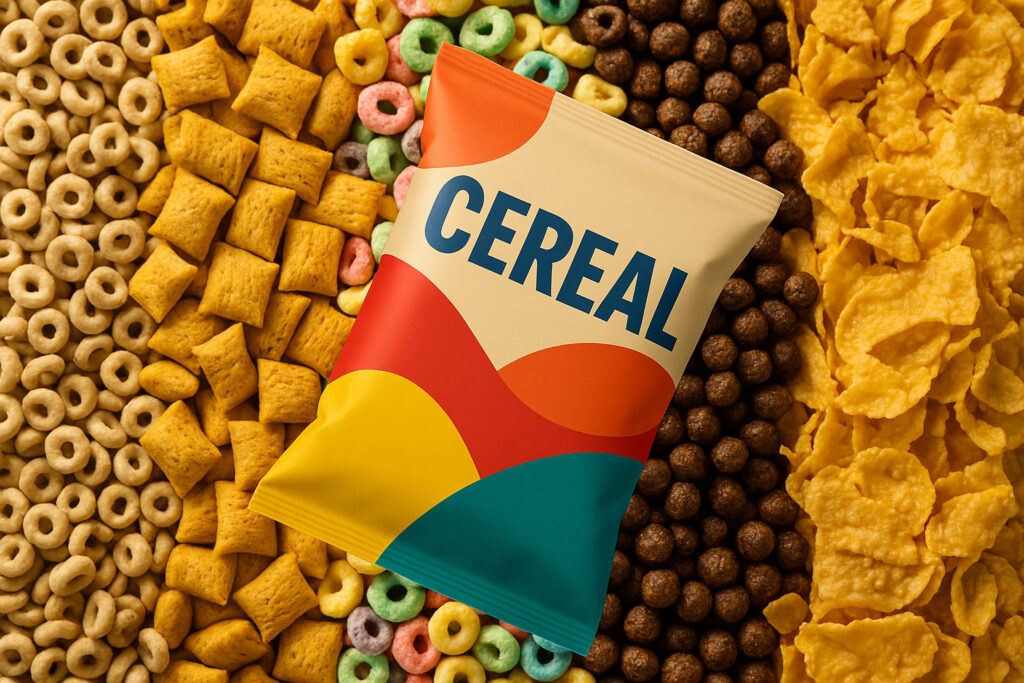Cereal Packaging Is Evolving. Here's What Smart Brands Are Doing About It.

The New Reality for Cereal Packaging
Not long ago, cereal packaging was straightforward: a liner in a box. Simple, predictable, and unchanged for decades. But in 2025, nothing about the cereal category is simple anymore. Shelf space is tighter. Consumer habits are shifting faster. And cereal isn’t just for breakfast.
Today, cereal packaging is a frontline player in brand identity, shelf competition, and operational performance. It’s not just about containing the product; it’s about protecting quality, meeting sustainability goals, supporting brand promises, and adapting quickly to changing market demands.
The smartest brands aren’t waiting for change to force their hand. They’re designing their packaging systems for the market they know is coming.
From Staple to Snackable: Why It Matters
The breakfast table has moved. According to Innova Market Insights, 27% of consumers in the U.S. and Canada have increased their cereal consumption in recent years, however, much of that growth is happening outside breakfast hours. Cereal is now a smoothie mix-in, a mid-afternoon snack, or a portion-controlled treat for travel and work.
This change has big implications for packaging. Cereal bags now need to be:
- Portable: easy to carry, store, and open on the go
- Fresh-keeping: seals that hold up through multiple uses
- Right-sized: meeting portion-control expectations for snack occasions
- Brand-consistent: delivering the same high-quality feel across SKUs and channels
At the same time, health-forward product trends are reshaping the aisle. In North America, more than half of new cereal SKUs now feature claims like “whole grain,” “gluten-free,” “high fiber,” or “no added sugar.” Heart-health claims rose 55% year over year. These claims make packaging performance critical because one bad seal isn’t just a waste of product; it’s a broken brand promise.
Why Pillow Bags Are on the Rise
While paperboard cartons still hold a majority share, roughly 65% of the cereal market, according to Mordor Intelligence, flexible pillow bag formats are steadily gaining ground. Industry analysts project flexible packaging in North America to expand at a 3–4% CAGR over the next several years, and pillow bags are central to that growth.
Their appeal is practical:
- Material efficiency: lower environmental impact and reduced freight costs
- Strong films: better product protection for flakes, puffs, and clusters
- Side gussets: more volume for club-size or bulk packaging
- Eurohole configurations: easy merchandising for hanging displays
- Varied sizing: enables seasonal SKUs, promotional packs, and trial formats
For cereal brands, pillow bags offer a path to diversify their product mix, serve multiple channels, and adapt to consumer needs, all while managing costs and sustainability goals.
The Problem With Older Systems
The challenge? Not every packaging line can handle these formats efficiently. For brands still running traditional box-and-bag setups, shifting to pillow bags can feel like trying to turn a container ship in a canal. Older systems often:
- Struggle with the sealing demands of modern films
- Require long, waste-heavy changeovers between SKUs
- Can’t easily switch between pillow bag variations and sizes
- Deliver inconsistent seal quality, risking freshness and product integrity
In a category where retailer demands can change overnight and where product launches may need to move from idea to production in weeks, these limitations are more than a nuisance. They’re growth blockers.
The Rise of the Packaging System
Smart cereal brands know that choosing the right format is only part of the equation. The bigger question is whether the system behind it can deliver consistently, quickly, and without unnecessary waste.
Modern operations demand packaging systems that:
- Change over in minutes, not hours
- Maintain accurate film tracking from the first bag to the last
- Produce strong, consistent seals every run
- Handle multiple pillow bag variations without extensive retooling
Technologies like servo-driven controls, tool-less forming collar changes, precise temperature regulation, and photo mark registration are becoming standard for competitive brands. These features cut setup time, keep scrap rates low, and maintain packaging consistency, even with different operators and shift changes.
Film compatibility is another key factor. With pillow bags gaining ground, the ability to run different films without compromising speed or seal integrity is critical. When machine and film work in sync, brands avoid waste, shorten downtime, and ensure every bag meets brand standards.
In short, for cereal brands competing in a fast-moving category, a packaging system that is precise, adaptable, and reliable isn’t optional anymore. It’s the baseline for growth.
Why It Matters Now
Here’s the thing. You don’t have to rebuild your product. You don’t need to reinvent cereal. But you do need to rethink the system that delivers it. Because cereal packaging isn’t a backdrop anymore, it’s a driving force.
The category is evolving. Consumers are changing how, when, and why they eat cereal. Retailers are changing what they expect from packaging. And if your line can’t support resealable films, multi-format flexibility, or high-speed changeovers, you’re not just losing time.
You’re losing opportunities. And in a category, this competitive, cereal packaging is where the wins begin.
In the next blog, we’ll dig into the machines that are solving the cereal packaging problems no one talks about and why system integration is becoming every operations team’s secret weapon.
But for now, if your packaging line still treats cereal like it’s only eaten at 8 a.m., it might be time to update your calendar.
Let’s Talk Cereal Packaging
The cereal aisle is changing fast and your packaging line should be ready to keep pace. Whether you’re exploring pillow bag formats or upgrading for faster changeovers, we can help you build a system designed for growth.